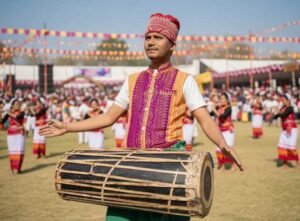Bodo Kham: Traditional Drum of the Bodo Community
1. Introduction
The Bodo Kham is a traditional percussion instrument, widely associated with the Bodo tribe of Assam.
It holds great cultural, religious, and ceremonial significance in the Bodo society.

2. Physical Description and Construction
The Kham is a long cylindrical drum, usually 3 to 4 feet in length and about 21 to 30 inches in diameter.
Traditionally crafted from local woods such as:
Jackfruit (Artocarpus heterophyllus)
Mango (Mangifera indica)
Ditabark (Alstonia scholaris)
Sterculia villosa
Both ends of the wooden hollowed body are covered with deer skin or goat skin.
The braces or bindings are made from buffalo hide which help to tighten the drum heads for the desired sound.
3. Playing Style and Sound
Played by striking with hands or sticks.
Produces deep, resonant, powerful beats that invoke a spiritual atmosphere.
The drum’s sound is central to rituals, calling upon deities and spirits.
4. Cultural Significance
Integral to major Bodo religious ceremonies, especially:
Kherai Puja (a major Bodo religious ritual)
Garja Puja (another ceremonial occasion)
Accompanies ritual dances, chants, and offerings.
Beyond the Bodos, it is also used by other indigenous tribes in Northeast India, including Tiwa and some Tripura communities, although it holds the deepest significance for the Bodos.
5. Role in Social and Cultural Identity
The Kham symbolizes connection to the spiritual world for the Bodo community.
It is not merely a musical instrument but a cultural emblem that reflects Bodo traditions.
Played at festivals, religious rites, and community gatherings strengthening communal bonds.
6. Summary Table of Kham
| Aspect | Description |
|---|---|
| Instrument Type | Traditional drum (percussion) |
| Size | 3 to 4 feet length, 21 to 30 inches diameter |
| Wood Materials | Jackfruit, Mango, Ditabark, Sterculia vilosa |
| Drum Head Material | Deer skin or goat skin |
| Bindings | Buffalo hide |
| Playing Method | Hands or sticks |
| Key Ceremonies | Kherai Puja, Garja Puja |
| Cultural Significance | Spiritual invocation, ritual and social symbol |
| Usage Beyond Bodos | Tiwa and Tripura tribes in Northeast India |
